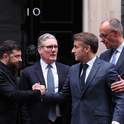A quiet revolution has been underway over the past decade in Britain’s diplomatic service, as more and more women are occupying the UK’s top diplomatic posts.
It is years since the leadership of the Foreign & Commonwealth Office realised that it could not represent UK society, or credibly promote gender equality abroad through initiatives such as “Preventing Sexual Violence in Conflict” and the #LeaveNoGirlBehind education campaign, without more women as ambassadors. The number of female appointments has grown steadily and 30 per cent of the UK’s 160 heads of mission are now women. However, until recently, very few have reached the most senior and sought-after ambassador roles.
With the appointment so far in 2020 of Karen Pierce as Ambassador to the US, Barbara Woodward as Permanent Representative to the UN, Caroline Wilson to China, Jill Gallard to Germany and Deborah Bronnert to Russia, many of the most important positions are now held by women—often for the first time in centuries of diplomatic relations. This is no blip. It continues an upward trajectory of appointments of women to G20 countries and other senior diplomatic posts abroad. Around half of the top heads of mission, including those in Australia, Canada, Italy, Mexico, Nigeria, Kenya and the UK Delegation to NATO, are now women. Many—like Pierce, now on her fourth head of mission post—are highly experienced, having served in multiple ambassador roles.
“When I joined the FCO in 2001, there were very few senior women and very few female role models,” says Judith Gough, the UK’s Ambassador to Sweden, who has also served as ambassador to Ukraine and Georgia. “This came as a shock after six years working in the private sector. But I can honestly say that the Foreign Office has changed over the past two decades, with more support and encouragement for women to reach the top and more talented women coming up through the ranks. There is, of course, still some way to go, but the path is firmly set and I expect the number of senior female diplomats to grow.”
It has been a slow process getting to this point. Women did not become eligible to join the diplomatic service until 1946. Even after that, recruitment of women remained limited. Until 1972, their letters of service required them to resign on marriage. The first female heads of mission were appointed in the 1970s, but remained few in number and the early pioneers were all unmarried. The first married female ambassadors were not appointed until 1987—12 years after Margaret Thatcher became leader of the Conservative Party.
Old-fashioned attitudes persisted for years after that. When I joined the FCO in 1990, there were still only a handful of senior women in the service and one of those, Pauline Neville-Jones, famously resigned in 1996 after being passed over as Ambassador to France. Coming from the rather female-dominated world of book publishing, I was astonished in my first FCO job to hear colleagues refer to “the girls’ room,” which meant the room where the (all female) secretaries typed up drafts sent to them by (predominantly male) desk officers.
Although the number of women in senior posts gradually increased in the early 21st century, it remained axiomatic for many that, as hard as the FCO might try to nurture female talent, the challenges of juggling mobility and family life would make it more difficult for women to reach the top. The underlying, often unspoken, assumption was that male partners would be less willing to follow women around the world.
The change in recent years has come about partly as a result of the efforts of a series of FCO leaders to create a more inclusive and family-friendly approach. “When I joined the FCO, it had a rather monochrome culture,” says Simon Fraser, who served as Permanent Under-Secretary (PUS) from 2010-15. “Changing that has required a sustained push over time to ensure women feel they can succeed in the organisation. It’s partly about having the right recruitment policies and bringing diverse talent through the system, but it’s also about creating a culture that supports diversity and inclusion through things like flexible working, job shares and maternity policies.”
In 2018, mirrors were installed along a corridor in King Charles Street, representing senior diplomatic posts never yet occupied by a woman. The idea is to encourage female staff to envisage themselves in top leadership roles. Fewer and fewer mirrors are left.
With the announcement that Philip Barton will take over from Simon McDonald as PUS of the newly formed Foreign, Commonwealth & Development Office (FCDO) next month, there is no imminent prospect of a woman leading the diplomatic service. However, a number of other key diplomatic posts are due to change hands soon, including the ambassadors to the EU, France, Japan, India, Brazil and South Africa. More top female appointments are doubtless in the pipeline. The ongoing merger with the former Department for International Development, which has an almost equal gender balance in senior roles, should bring more talented women into the frame for top jobs.
At a time when the government is hardly a model of gender balance—just 27 per cent of the cabinet are women—the FCO can be proud of the progress it has made. However, there is a long way still to go. While the overall gender balance has much improved, the FCO Senior Management Structure, especially the most senior level, is still dominated by men. The proportion of female ambassadors in the UK service is similar to the US and French, but lags far behind countries like Sweden, around half of whose ambassadors are female. The FCO is nowhere near its aspiration of 50 per cent female representation in the Senior Management Structure by 2023 (the current figure is 37 per cent).
“It’s reassuring that women are now being appointed to top jobs,” says Karen Betts, a former Ambassador to Morocco and now CEO of the Scotch Whisky Association. “But the FCO culture has been pretty inflexible towards diversity of all kinds (gender, ethnicity, background) for many years. This needs to shift, and it will take sustained determination on the part of the FCO leadership.”
Two years ago, in her foreword to the FCO’s Women and the Foreign Office, Nicola Brewer, a former High Commissioner to South Africa who went on to become Chief Executive of the Equality and Human Rights Commission, wrote “today I can think of a lot of talented women who deserve to be in the lists for top diplomatic posts. Paris, Washington, PUS are, for now, still just the other side of the glass ceiling.” While achieving a full gender balance at all levels remains a work in progress, the glass ceiling at last seems to be on the point of collapse.
Rupert Joy is an international consultant and former diplomat. He was UK Ambassador to Uzbekistan from 2009-12 and EU Ambassador to Morocco from 2013-17
2020: the end of the diplomatic glass ceiling?
Women are at last being appointed to the UK’s top diplomatic posts
August 11, 2020

Barbara Woodward, new UK Permanent Representative to the United Nations in New York. Photo: PA Images











